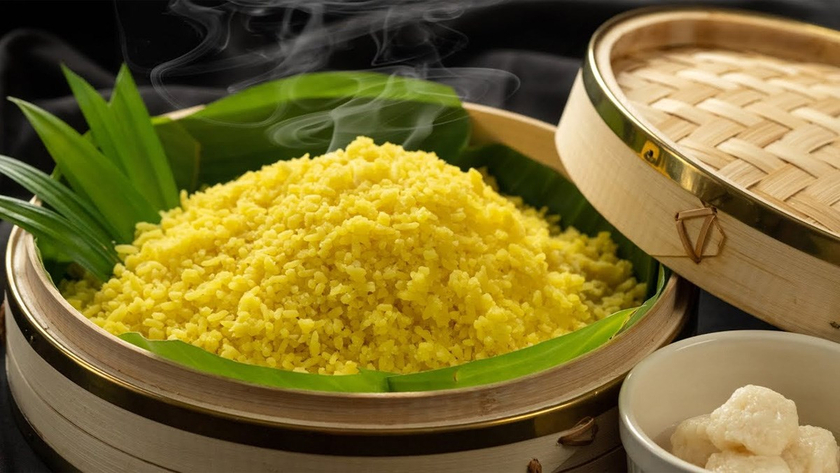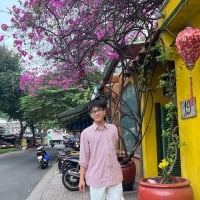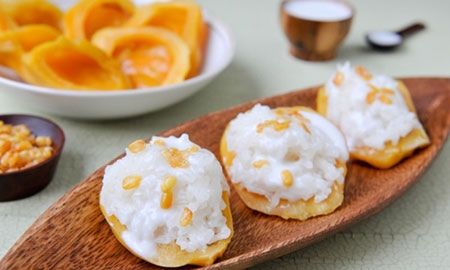Xoi, a dish made from sticky rice, has been a part of Vietnamese cuisine for centuries. Xoi brings together healthy eating habits and culinary pleasures in perfect harmony. It is no exaggeration to say that xoi is “the embodiment of the quintessence of Vietnamese cuisine.”
Rich and diverse ingredients
The main ingredient to make sticky rice is usually glutinous rice. Original sticky rice usually only has glutinous rice with a little salt to create soft ivory-white sticky rice grains. Most other types of sticky rice are combined with flavorings such as purple leaves (purple), pandan leaves or galangal leaves (green), gac fruit (red), gardenia powder or turmeric powder (yellow). Or many types of decoctions from leaves, tubers, and roots of various plants to create colorful sticky rice.

Five-color sticky rice.
In addition, sticky rice is often combined with many different ingredients such as: corn, green beans, red beans, black beans, taro, lotus seeds, gac fruit... This diverse combination not only creates interesting colors, but also brings very unique flavors to each type of sticky rice.
Sophisticated processing techniques
To make delicious sticky rice, first of all, the selected sticky rice must meet the standards. Depending on taste, there are many different types of sticky rice to bring different flavors and stickiness. There are 5 popular types of delicious sticky rice that are often used: yellow flower sticky rice, Tu Le sticky rice, Dien Bien sticky rice, goose sticky rice, and velvet sticky rice.

Sticky rice is soaked in fresh turmeric water to create an attractive yellow color.
Glutinous rice is carefully screened, soaked in water with natural colors and flavors, such as turmeric water, purple leaves, crushed... It can also be combined with gac seeds after being soaked in water for a long time. Then, put all the prepared ingredients into the steamer to steam the sticky rice. The aroma, deliciousness, and stickiness of the sticky rice depends not only on the soaking time, temperature, and steaming time, but also on the skill and sophistication of the person preparing it.
Flexible combination with spices
After being cooked, sticky rice is also combined with spices such as roasted peanuts, fried onions, scallion oil, coconut milk, black sesame, sugar, salt... This combination creates a rich, unique and delicious flavor. In Hanoi, sticky rice with xeo is memorable with its bright yellow color made from turmeric water, and crushed green beans covered with fragrant fried onions, shredded pork... Meanwhile, in Saigon, the typical sweet sticky rice dish, served with sugar, coconut milk, and coconut rice threads - is a familiar dish to many people.

Other variations of sticky rice are combined with sausages, Chinese sausages, braised pork with eggs, cinnamon sausage, pork roll, shredded pork floss... The dishes served with sticky rice are becoming more and more diverse, offering countless choices for diners' sweet and salty preferences.
In addition, some forms of packaging sticky rice using lotus leaves, banana leaves... also bring a unique aroma, keep the sticky rice warm longer and safe for health. According to Condé Nast Traveller, no matter how it is enjoyed - on the street or in a luxury restaurant, sticky rice is always "the embodiment of the quintessence of Vietnamese cuisine".
Dishes to meet diverse needs
Sticky rice is often chosen as a breakfast food because it is "filling", giving a feeling of fullness for a long time. Sticky rice provides a large amount of carbohydrates, providing abundant energy, combined with side dishes often rich in protein such as meat, beans or nuts, making the dish nutritious and delicious.
In addition, sticky rice can also be flexibly customized to meet the needs or specific dietary preferences of diners. For vegetarians, sticky rice becomes even more useful because it can be used regularly.
Connection to culture and tradition
Sticky rice has appeared since ancient times, becoming an indispensable part of normal days to important milestones in the lives of Vietnamese people until now.

Sticky rice is an indispensable dish in special events of Vietnamese people.
When we were young, sticky rice was an indispensable offering in the first birthday party, and also had to be present in the Mother Goddess Worship Ceremony. When we grew up, sticky rice appeared in weddings and engagements with bright colors and impressive shapes. Or in the offerings to ancestors and New Year, there must be a plate of sticky rice. Sticky rice often appears in holidays, worship days, weddings, and is an indispensable part of Vietnamese family meals.
Sticky rice is not only a rustic dish, but also carries cultural and traditional values, associated with many important customs in the spiritual life of Vietnamese people.


































